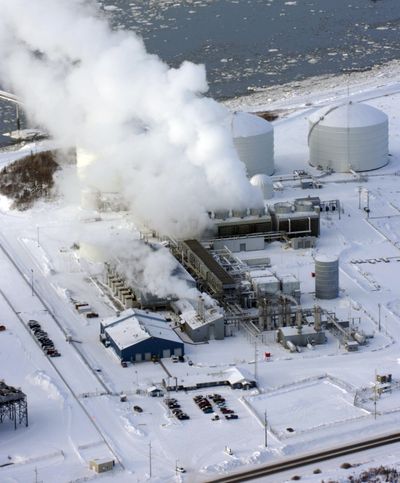Alaska natural gas pipeline project site selection advances

JUNEAU, Alaska – The companies seeking to advance a multibillion-dollar natural gas pipeline project in Alaska have a leading contender for the terminal site where gas would be liquefied and shipped to Asia, signaling that a decades-old dream could become a reality even though major hurdles remain.
Exxon Mobil, BP, ConocoPhillips and TransCanada Corp. announced Monday that the Kenai Peninsula town of Nikiski is the leading contender. Senior project manager Steve Butt said three or four other sites are still being considered, but Nikiski has the land needed for the plant and the companies know they can route a pipeline there. Land acquisition work is underway. He declined to identify the other sites.
Another advantage for Nikiski, a town of about 4,600 people located 10 miles north of the city of Kenai, is that routing a pipeline there would allow the state’s major population centers, including Fairbanks and Anchorage, to access gas from the line, he said.
A liquefied natural gas plant operated in Nikiski for decades and provided exports to Japan. But ConocoPhillips and its then-partner, Marathon Oil Corp., announced plans to close the plant in 2011, citing market changes. Sporadic shipments continued until ConocoPhillips decided earlier this year not to renew its export license. The state has asked ConocoPhillips to reopen the mothballed site and apply for a new license to provide an incentive for petroleum companies to explore and invest in Cook Inlet.
Butt said the liquefied natural gas plant envisioned as part of the pipeline project would be 16 or 17 times larger than that plant.
Alaskans have long dreamed of a gas line as a way to shore up revenues as oil production – Alaska’s economic lifeblood – declines, create jobs and provide energy for residents. Monday’s announcement was another step toward building a gas pipeline to rival that of the trans-Alaska oil pipeline, though the companies have not yet committed to building and continue to stress the need for “competitive, predictable and durable” terms on oil and gas taxes and royalties to pull the project off.
The pipeline envisioned would span 800 miles from the prodigious North Slope to south-central Alaska, and the mega-project could cost $45 billion to more than $65 billion.
“A Nikiski area liquefaction plant and export terminal will be a multi-billion investment and huge shot in the arm to both Alaska’s economy and confidence in our state’s energy future,” U.S. Sen. Mark Begich, D-Alaska, said in a statement. “A gas line from Prudhoe Bay to the Kenai Peninsula can meet Alaska’s in-state energy needs while supplying the energy-thirsty countries of the Asia Pacific.”
The initial focus of the project was to have a pipeline run from the North Slope into Canada to serve North American markets. But progress stalled, and Gov. Sean Parnell, in a bid to get things going again, urged Exxon Mobil, BP and ConocoPhillips – the North Slope’s three major players – in 2011 to get behind a project that would allow for liquefied natural gas exports to the Pacific Rim if the market had truly shifted away from the Lower 48.
Parnell set out a series of benchmarks for the companies to meet in 2012 and 2013, and they met all but one – moving into a stage that would include preliminary engineering work and setting up a financing plan. The companies have said that step would trigger hundreds of millions of dollars in additional spending by them, something Parnell wanted to see. But the companies reiterated their desire for a stable fiscal environment.
Parnell, in June, said missing that deadline meant he was under no obligation to pursue taking up possible gas tax legislation this year.
Butt said the gas tax issue needs to be addressed during the upcoming legislative session, which begins in January. He said there is uncertainty about what the gas tax on production would be.
“You need to know what are predictable and durable terms,” he said.